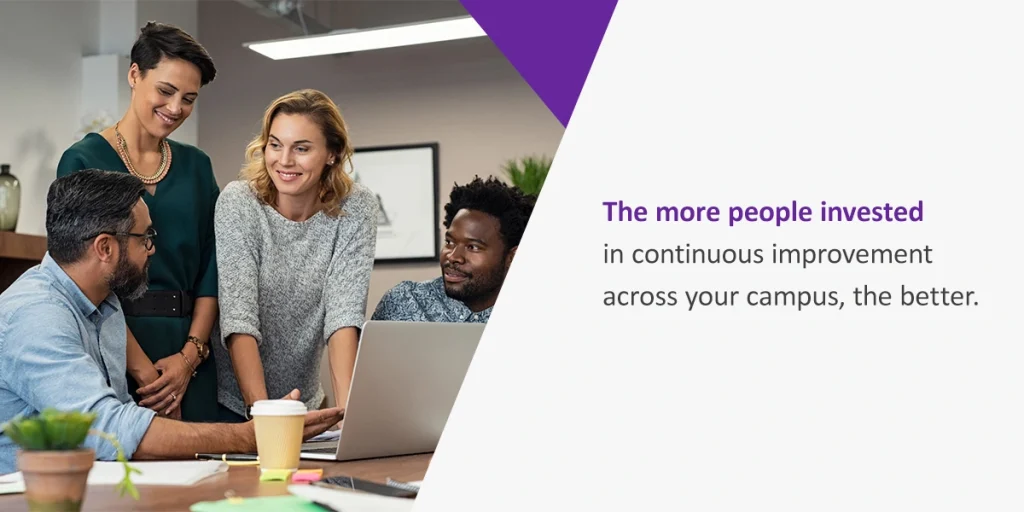




Higher education institutions must have strategic goals and a clear vision to remain competitive. However, establishing these objectives is not enough to propel your college or university toward success.
To truly prosper, your institution must align its campus and systems around your strategic goals to create a collaborative and cohesive environment that fuels your overall development. Working towards and reaching these objectives involves integrating and updating various processes. Below, we share actionable tips for aligning your campus around your strategic goals for accreditation and long-term growth.
Strategic alignment refers to the process of implementing new practices or updates into a business or organization’s operations to reach its objectives more quickly.
Higher education institutions can create intentional goals to help them improve their campus systems to reach accreditation standards and ultimately improve academic outcomes. Administrators, faculty, students, and campus systems must all work together to create the most beneficial educational experiences possible. With proper planning and preparation, colleges and universities can establish policies, procedures, and operations to meet required standards and advance the institution’s academic quality.
Higher education goal alignment is a key driver of success for higher education institutions. It helps foster a culture of ongoing improvement and opens the doors to greater opportunities that benefit students and staff.
Every higher education institution should strive to deliver better and more beneficial experiences for their community. Your college or university can evolve and achieve the following when you successfully align your strategic goals and campus systems:
Colleges and universities can take measures to refine and improve their campus systems to boost the likelihood of reaching their strategic goals.
Explore the following steps to align your campus around your institution’s primary objectives:
It is important to learn more about the specific accreditation standards your institution needs to meet. Becoming familiar with these requirements will help your team gauge where your college or university currently stands.
Begin by gathering resources from the accrediting body and reviewing their specific criteria. Study the accreditor’s guidelines and get to know them well. They will influence your decision-making and the goals you prioritize.
A comprehensive evaluation of your existing campus systems is crucial. During this assessment, you’ll identify your college or university’s strengths and weaknesses. You will also want to find any gaps that could compromise accreditation readiness.
Every institution should assess the following to gauge their quality and efficiency:
After assessing your processes and learning more about applicable accreditation standards, your institution can use its findings to develop strategic goals to improve your campus systems.
These goals should be intentional and specific, targeting the systems across campus that are ultimately holding your university or college back. For instance, you may make revitalizing student career services a strategic objective if you find your existing processes are not delivering the desired results, such as pairing individuals with internships or finding job opportunities for soon-to-be graduates.
The key to choosing advantageous goals beyond what is necessary to receive accreditation is establishing a clear vision for the future. Your college or university can then choose pursuits and initiatives that contribute to this vision.

Faculty members, students, administrators, and other community members will play a key role in aligning your campus with these objectives, and they will help your university or college make positive changes more quickly.
Collaborating with the people who keep your institution running on a daily basis can also help you gain insight into any inefficiencies or areas of improvement from their experiences. The more people invested in continuous improvement across your campus, the better.
Seminars, workshops, and online programs can help your staff understand their unique roles in refining your campus systems and striving toward strategic goals. Highlight how each department can contribute to your institution’s success. Consider their strengths and weaknesses, then use that information to align their work with your overarching goals.
In addition to offering training, encourage your professors, staff, and administrators to participate by sharing their feedback and ideas. Their input is extremely valuable and can guide decision-making when working on new practices and campus systems.
Data will play a huge role in aligning your college or university’s processes with its strategic goals. Having accurate, timely, and reliable data collection tools will offer greater insight into your college or university’s compliance with accreditation standards.
Finding software solutions that can gather performance and programmatic data will make collecting and analyzing your systems remarkably easier.
Once you establish programs or procedures for obtaining data, your institution should regularly review and analyze these insights to do the following:
Another step in aligning your campus with its strategic goals is acknowledging the successful initiatives and those that could use editing. Spotlight the individuals and departments making the biggest difference in your strategic goals and recognize the benefits of their contributions to the institution as a whole.
Along with the successes, you’ll also want to highlight the initiatives that are not helping your campus systems improve. Your shortcomings are not an indication of failure — they’re an opportunity for growth. Encourage your faculty, students, and administration to share their feedback and make prompt adjustments to processes that are not aligned with your strategic goals.
Supercharging your strategic alignment process with continuous improvement principles is one of the best ways for colleges and universities to harness long-term, sustained growth. These key principles include:
By prioritizing ongoing efforts to improve your operations from top to bottom, you can foster a culture at your institution that values reflection, flexibility, and progress. The right solutions and tools can make automating repetitive tasks and redundant systems simple, so your faculty can focus on delivering the best learning outcomes to students and finding new ways to achieve alignment.
Your higher education institution can turn to Watermark for planning and accreditation software designed to streamline the accreditation preparation process. Our award-winning platform allows you to easily manage assessment planning and implement continuous improvement principles to elevate your operations.
With Watermark Planning & Self Study, your institution can improve campus collaboration with an integrated hub that unifies all your outcomes, planning, and assessment data. We make evaluating program effectiveness simple and collaborative, so your institution can reach its strategic goals more efficiently.
Request a demo to see how Watermark software can enhance your institution’s strategic goal alignment.






























































































































































































































































































































































































